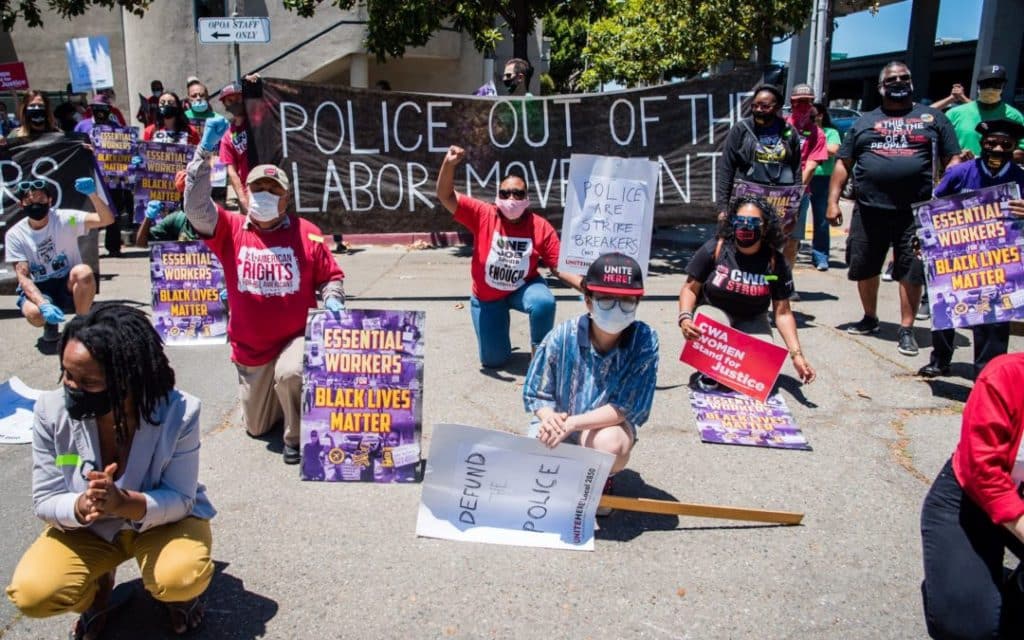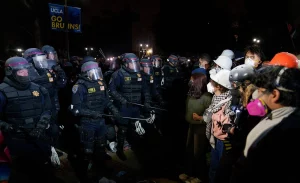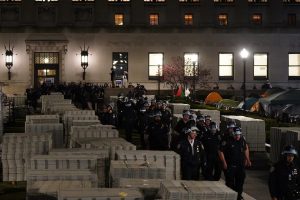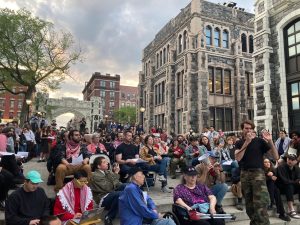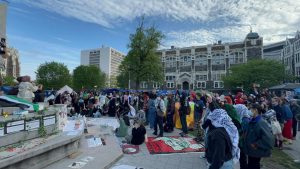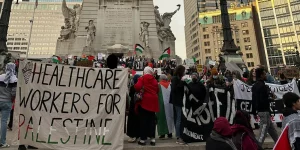The United States is witnessing the phenomenon of Generation U. This generation is an expression of the shifted consciousness of young workers today — workers who are embracing socialist ideas, are in favor of labor unions, and who are challenging exploitation either through leaving their jobs in large numbers, or challenging corporate behemoths like Amazon and Starbucks directly in union drives.
This dynamic moment of high labor militancy is all connected to the struggle for Black liberation within the Black Lives Matter (BLM) movement, where we take to the streets or fight in our workplaces for a world where Black lives matter, which in this racist society they do not. The militancy we see today is a continuation of the combativeness we saw in the multi-racial 2020 BLM uprising that exploded due to the brutal murder of George Floyd by police —one of the largest uprisings in U.S. history that sparked international protests.
The powerful connection between the 2020 BLM uprising and the current moment characterized by Generation U highlights how the fight against oppression and exploitation are tied together, and that capitalism must be destroyed to destroy racism.
What Caused the Uprising
The 2020 BLM uprising was sparked by mobilizations for democratic demands against police murder and violence against Black people. This uprising happened in the context of the contradictions of Capitalism that were exacerbated by Covid, which disproportionately affected Black people. Black people were more likely to test positive for Covid and were more likely to die from it. In Milwaukee, at the start of the pandemic, Black people made up 81 percent of Covid deaths while making up just 26 percent of the population. This overrepresentation of Black mortality comes from discrimination that keeps hospitals in Black communities underfunded and housing segregation, and from economic disparity that has made the unhoused population — which is more vulnerable to disease — 40 percent Black.
Black people were also often the “essential” workers forced to put themselves at risk to work in places like supermarkets and Amazon warehouses without proper PPE or sanitation of their workplaces. This was because capitalists wanted to continue making profits by forcing the most precarious sectors of society to continue working. Capitalists also refused to pay for equipment and sanitation demanded by workers.
Furthermore, in 2020, Black people faced a higher rate of lay-offs than white workers: 17.8 percent compared to 15.5 percent, respectively. During the recovery period, Black workers also experienced the slowest job recovery.
The economic despair and the human toll brought by the misery of capitalist society once again hit Black people the hardest, thanks to the inherently racist system of oppression and exploitation that profits off our pain, loss, and corpses. This system requires precarity for Black workers and a police force to maintain that disparity by targeting Black people for brutalization or imprisonment.
This structural set up of capitalism that caused the death of Black workers in Amazon facilities also caused police to murder George Floyd. When Floyd was killed, it was the last heartbreak from this system people were willing to endure. Thus they took to the streets across the nation and around the world to challenge it.
Where the Militancy Went
Both political parties saw — and feared — the power inspired in the working class by the fight for Black liberation. While Republicans openly called for repressing the movement, the Democratic party sought to both repress and co-opt it. In an act of cringe, Democrats donned Kente cloth and did performative photo opps of them kneeling to express faux-solidarity with the movement. Meanwhile, off-camera, they were calling the national guard to repress protesters.
Bureaucratic tendencies in the movement also played a major role in its cooptation. In December 2020, ten BLM chapters filed a statement calling for greater transparency and more democratic decision making for the national network. This was in large part due to the leadership of the Global Network making decisions unrepresentative of the movement; namely this leadership’s support for the Democratic party and alliance with capitalists. As Darrin Johnson, a member of the Black Power Collective, a BLM branch that broke from the Global network, puts it:
The issue of greatest concern for us is the relationship between the Global Network and the Democratic Party. This is hypocritical at best, as the Democratic Party has historically rejected and ignored BLM’s demands and has made it clear that they are pro-police, pro-prison, and committed to capitalism….This is a party that is a threat both here and internationally. To ally with them is to ally against ourselves.
This leadership, along with making financial decisions without communicating with the rank and file, also partnered itself with capitalists like One United Bank and Levi Jeans that profit from and exploit Black people every day.
Ultimately, these disingenuous expressions of solidarity and the betrayal of the movement by NGOs co-opted the movement and directed people out of the streets and to the polls to elect Joe Biden and others — politicians who are currently inflating police budgets in preparation to repress the next uprising.
But the conditions of Black oppression and exploitation still persist even with the movement out of the streets. Therefore, so too does the militancy of in a new form. The anger and the willingness to fight by the Black vanguard and the participants in the uprising has bled into the current labor militancy of Generation U. Their fight continues now against the corporations that left workers, particularly Black workers, to die during the pandemic.
The initial organizing against Amazon at the Bessemer warehouse in Alabama was in the tradition of BLM in that it connected the struggle for Black liberation with improving working conditions, namely for Black workers who are among the most precarious. Many of the workers at the mostly-Black Amazon facility participated in the 2020 protests and then reached out to the union due to the grueling nature of their work.
The founding of the Amazon Labor Union (ALU) was a continuation of the effort that began at Bessemer. The victory of the workers at the JFK8 Staten Island facility, was a powerful demonstration that workers could challenge the most powerful capitalists and win, thus changing the landscape of labor organizing. This effort was led by Chris Smalls who was influenced by the tradition of Black labor organizing and BLM movement.
The influence of BLM can be seen in how the fight for greater rights for Black workers was central to the unionization effort because it began with a walk out over unsafe working conditions faced by a mostly Black workforce over Covid. It is also shown in the anti-police “Fuck 12” chants, remniscent of the BLM protests, being heard at ALU rallies and even the 2022 Labor day march called for by the ALU.
Many of the union activists in the Starbucks unionization wave also come from the BLM movement, and see the fight against discrimination as the same as the fight for better working conditions. These harsh conditions impact a large workforce, half of which is made up of people of color. Due in part to the ideological and political influence of BLM, Starbucks workers like Casey say “You can’t be pro-LGBTQ, pro-Black Lives Matter, pro all these things and be anti-union.”
Even the teachers’ strike that occurred this year in the birthplace of the 2020 uprising, Minneapolis, began over Black oppression. When the union proposed a Memorandum of Agreement (MOA) to provide protections from lay offs for educators of color, the city rejected it, and the strike began. The strike’s central demands were anti-racist, calling for greater hiring and retention of educators of color and increased wages for a workforce composed majorily of people of color making poverty wages.
An Independent Party to Fight against Exploitation and Oppression
Many leftists neglect the importance of the struggle for Black liberation within the American labor movement and struggle for socialism. However, Black liberation has always been a catalyst in igniting greater militancy within the American working class and even the international working class. It has also served to inspire the working class to see themselves more as workers by understanding that liberation requires challenging the state and the bosses. For example,the Dodge Revolutionary Union Movement (DRUM) were influenced by the Black Power movement and saw the labor movement as a strategic place to combat both the social oppression they faced and capitalist exploitation suffered by all workers, especially Black workers. These movements encouraged the multiracial working class to use its own independent methods and strategic position to shut down production to fight for Black liberation against the Capitalist system.
In order for a socialist party independent of the bourgeoisie to be able to guide the working class to revolution, it must deeply engage in Black struggle, understand the influence Black struggle has on class struggle, and have a revolutionary socialist program towards Black liberation. In order to combine the dynamism of the social movements and the strategic advantage of labor struggle to end Capitalism — the greatest material force of racism.


